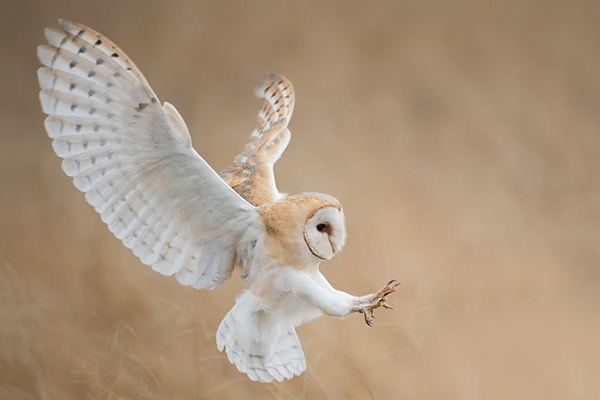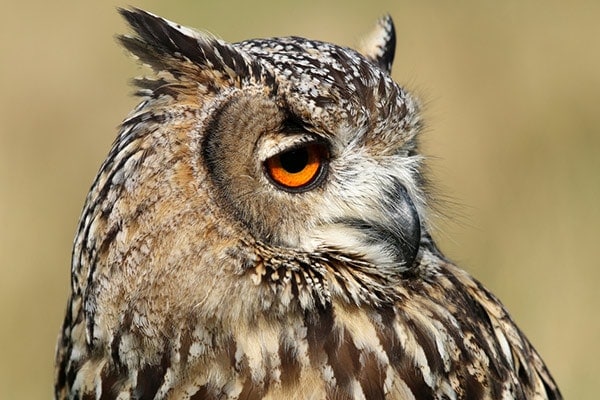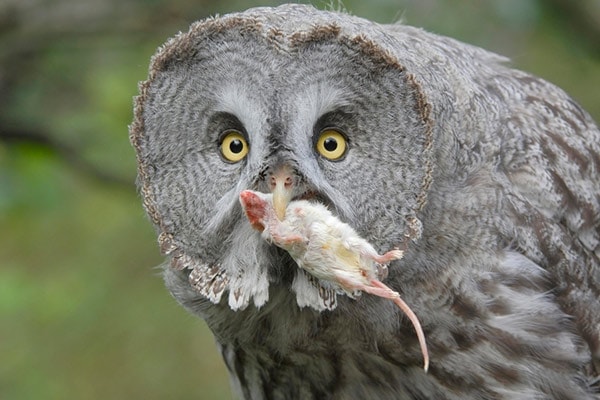Contents [show]
Owls may look cute and cuddly, but don’t mistake them for that. They are one of the deadliest predators in the animal kingdom. I have researched them enough to inform you about how they hunt.
Owls hunt using their super senses. One sense that owls use all of the time is their super-hearing abilities. Their dish-like faces act as a soundboard that focuses and amplifies the sound to their ears. Some have A-symmetrical hearing that allows them to hear sound in multiple dimensions. Using this, they can pinpoint where their prey is and dive to catch them up to 2 feet underground.
Throughout this article, we will be discussing topics like:
- How do owls hunt at night?
- What does an owl’s diet consist of?
- The digestive tract of an owl
- Pellets and their importance
Heads Up, Talons Out: How Owls Hunt In The Dark

Owls are one of the best hunters in the animal kingdom. They have senses like no other that they use to hunt their prey. Many different species hunt slightly differently but still use the same senses to get a meal.
Whether the owls are nocturnal or diurnal, one of the senses that theory use is their sense of sight. The owl’s eyes are designed to see exceptionally well in low-light conditions.
They can see in the dark eight times better than humans.
Their eyes are fixed in their heads and don’t rotate as other animal’s eyes do.
Sense of Hearing
Perhaps the most critical sense for the owls is their sense of hearing. They are one of the few animals that make use of this sense when they hunt. There are at least two types of ears that owls have. When the species of owl has a flat, dish-shaped face, their faces act as a sounding board where the sound that they hear bounces off and goes straight in their ear giving them the exact location of the sound. In this case, the prey.

Asymmetrical Ear Openings
Some owls have asymmetrical ear openings and have hearing receptors in their brains. One opening is higher than the other to aid in locating where the sound is coming from. With the difference in the ears’ placement, owls will hear the sound at two slightly different times.
They say that the sound difference is 30 millionth of a second, in some instances, to pinpoint exactly where their prey is located. Aside from that, they also have asymmetrical flaps in front of their ears that act as antennas to locate the vertical distance of their desired target.
When they determine their prey’s precise location, they fly down from where they are and dive at their intended target’s exact location.
And…
Owls make no sound, thus not alerting the small creatures.
This is because they have serrated wings that give them the stealth to swoop down and catch their meal. Once in the location, they release their talons and catch their dinner.
What Do Owls Hunt?
| Owl Species | What They Hunt |
|---|---|
| Barn Owl | mice, rats, voles, insects, lemmings |
| Barred Owl | small mammals, reptiles, birds, amphibians, fish, invertebrates |
| Boreal Owl | voles and mice, small squirrels, shrews, pocket gophers, small bird, insects, especially crickets |
| Burrowing Owl | grasshoppers, beetles, voles, squirrels |
| Eastern Screech-Owl | small insects, medium-sized mammals, birds, reptiles |
| Elf Owl | moths, crickets, scorpions, centipedes, beetles |
| Ferruginous Pygmy-Owl | grasshoppers, crickets, caterpillars, other large insects and scorpions, birds, small mammals, amphibians, reptiles |
| Flammulated Owl | insects, especially crickets, moths, beetles |
| Great Gray Owl | voles, pocket gophers, mice, shrews, squirrels, weasels, small birds, frogs |
| Great Horned Owl | skunks, hares, geese; on occasion would eat cats or dogs |
| Long-eared Owl | small rodents, small birds |
| Northern Hawk Owl | voles, mice, squirrels, weasels, shrews, small birds, insects, frogs, small fish |
| Northern Pygmy-Owl | mice, voles, small birds, lizards, gophers, squirrels, grasshopper, crickets, cicadas, beetles |
| Northern Saw-whet Owl | shrews, moles, and mice, other birds, insects, isopods |
| Short-eared Owl | mice, rats, lemmings, shrews, rabbits, gophers, bats, muskrats, small birds |
| Snowy Owl | hares, rabbits, lemmings, birds like geese & songbirds |
| Spotted Owl | squirrels, voles, rats, birds, reptiles, insects |
| Western Screech-Owl | insects, birds, scorpions, cicadas, mice, rats, gophers |
| Whiskered Screech-Owl | grasshoppers, beetles, moths, birds, rats, mice, voles |
What Is An Owl’s Diet?
Owls are called birds of prey for a reason. They are extremely carnivorous and will eat other animals such as small insects to skunks and even larger birds. The main food largely depends on the species of owl. For example, Barn owls will mainly eat mice or shrews. Screech owls, on the other hand, prefer insects mostly.

Then you have those that eat other animals such as hares, foxes, or even other birds of the same size. The Asian fish owls and the African fishing owls generally eat a pescetarian diet, primarily fish. However, most owls are opportunistic and will eat whatever prey is available.
When owls leave their owl nests, they are very efficient hunters of the night. They can carry prey at least twice as heavy as their own weight. They use the strength of their talons to kill and take their game. There are even some instances that owls have preyed on some not-so-lucky cats and dogs.
How Do Owls Eat And Digest Their Food?
Like many birds, owls actually cannot chew their food. Smaller prey is swallowed whole while larger prey is first torn up into smaller pieces before digging in
Owls do not have a crop which is a sac in the throat that serves as a place to store food for consumption at a later time. Since owls do not have this, food is directly passed into their digestive system and broken down. Here’s how it works.
- The food passes the proventriculus or the first stomach. Here, the proventriculus creates acids and enzymes that start breaking down the food.
- The next stage is when the food passes the gizzard. Here, the food is then separated into digestible and indigestible. Indigestible include parts such as feathers and bones.
- The digestible parts are then passed through the small intestine which is covered by enzymes from the pancreas and the liver. The small intestine is where owls will absorb the nutrients from their food.
- The cloaca is the temporary storage for the wastes from the urinary and digestive systems. This is because owls do not have bladders in their tiny little bodies.
- The waste is then excreted through the vent.
- After the owls eat, the wastes or the indigestible parts that have been stored in the gizzard are then compressed into a pellet.
- The compressed pellet is then sent up to the proventriculus where it can stay up to ten hours before being regurgitated
- Once the owl has regurgitated the pellet, it is now time for them to hunt and eat again. It will wait for it to spit out because the pellet is blocking the proventriculus.
Pellets: An Owl’s Footprints
Owl pellets are created from the indigestible parts of food that the owls eat. This includes bones, teeth, skull, claws, and feathers. Basically, anything that is too dangerous to pass through an owl’s digestive system.
These pellets are very sought after by many scientists as they are small footprints that owls leave behind. There is so much that we can learn through dissecting these pellets.
This will give scientists the ideas of the whole ecosystems of owls in their area. It will allow them to learn and understand more about these birds of prey. These pellets can also tell a lot about the behavior of the owl that it came from.
Pellets answer many questions that spark the minds of those who look for answers regarding these powerful predators. Are you ready to look for some pellets?
Do you want to read more about owls? Check out these blog posts:
- Where do owls go during the day?
- How long do owls live?
- How to attract owls to your backyard
- How long do owlets stay with their parents?
- Why do owls hoot?
- When do owls have babies?
